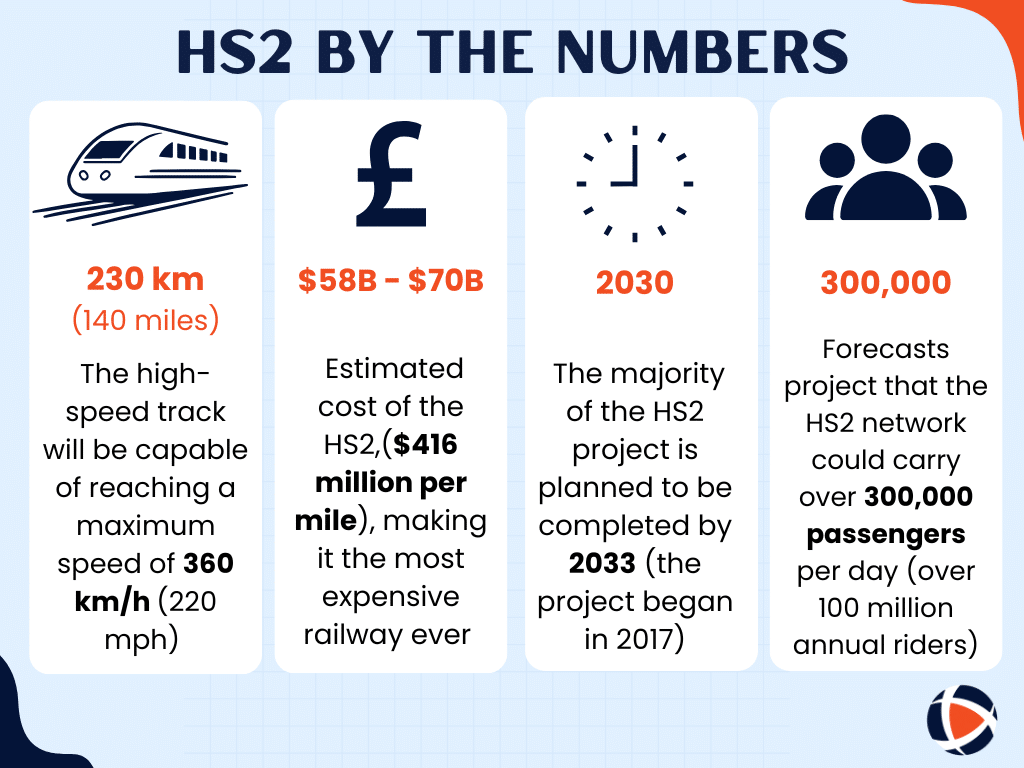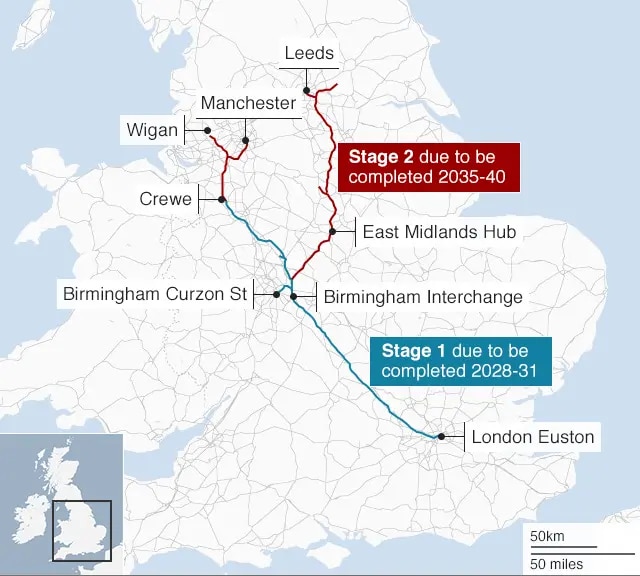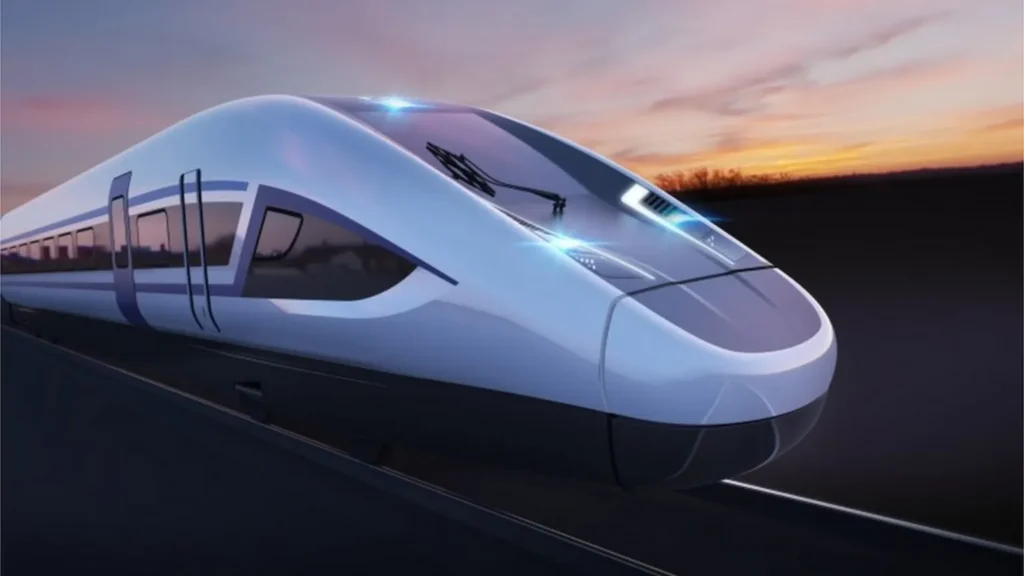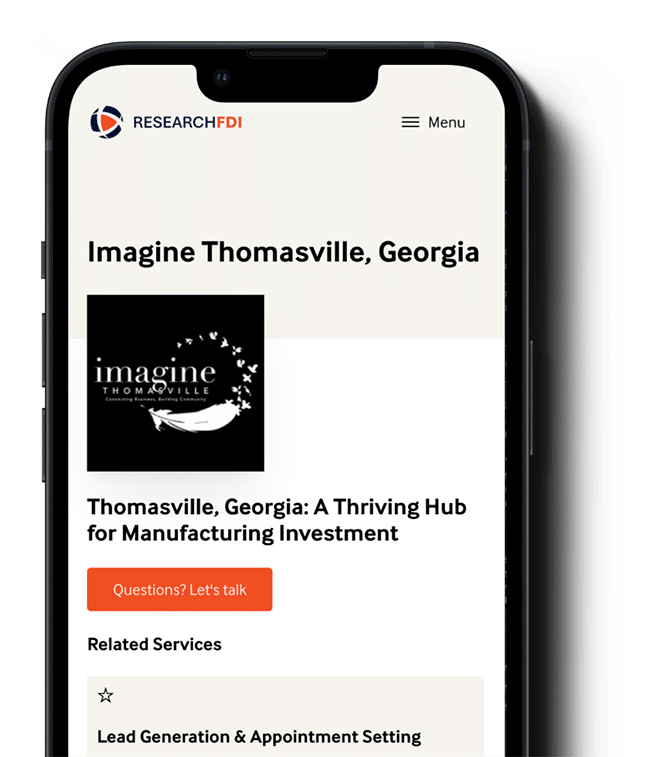The United Kingdom’s High Speed 2 (HS2) project is more than a rail line. Instead, we can see it as signifying a new era for high-speed connectivity and regional growth.
After more than a decade of planning, debates, and designs, HS2 has officially moved from blueprint to reality. Trains capable of reaching 225 mph will soon link the UK’s largest cities, cutting travel times and redrawing the map of economic opportunity.
But beyond engineering, HS2 represents something bigger: a shift in how nations prepare for the future of investment. As the UK strengthens its transport backbone, it’s also strengthening its case for foreign direct investment (FDI). High-speed rail corridors are more than just massive transport projects, they’re economic development platforms that unlock new business sites, supply chains, and workforce hubs.At a glance: HS2’s first phase (now under construction between London and Birmingham) is one of Europe’s most ambitious infrastructure projects. With an estimated cost exceeding £70 billion and completion slated for the mid-2030s, it’s expected to generate over 31,000 construction jobs, boost regional productivity, transport 300,000 daily riders, and reinforce the UK’s standing as a destination for high-value global investment.
What Is the High Speed 2 (HS2) and Why It Matters
Simply put, High Speed 2 (HS2) is designed to rewire how the UK moves and how its regions compete. The line’s first phase will link London and Birmingham, cutting travel times between the two cities to under 50 minutes. Later extensions are expected to connect to Manchester, and possibly integrate with the existing HS1 route to Europe.
The project’s scale is unprecedented for Britain. With an estimated cost between £67 billion and £82 billion, HS2 represents one of Europe’s largest infrastructure investments and a generational test of the country’s ability to deliver complex, future-focused transit systems.
But HS2 isn’t simply about faster trains. Its real value lies in the connectivity dividend, the productivity and investment gains unlocked when businesses, universities, and logistics hubs are linked by reliable high-speed transport. Regions once perceived as peripheral will soon sit within an hour’s reach of London or Birmingham, expanding labour markets and shortening supply chains.
For investors, this matters.
A stronger transport spine means better access to markets, skills, and infrastructure — three fundamentals that drive site-selection decisions and inward investment.
In this sense, HS2 is not just a railway; it’s a national economic development strategy running on steel rails.
HS2’s Economic Impact: Jobs, Supply Chains & Regional Growth

Construction jobs now, diversified careers later
HS2 supports tens of thousands of roles today and seeds long-term employment beyond the build phase. Think HS2 construction jobs (civils, tunnelling, rail systems) evolving into operations and maintenance (O&M), signalling, control room teams, rolling-stock servicing, station management, and customer experience.
- Near term: Civil engineering, plant operators, surveyors, environmental specialists, archeology, and site logistics.
- Mid term: Rail systems integration, power and signalling engineers, station fit-out, cybersecurity for rail tech, depot commissioning.
- Long term: O&M technicians, asset management, facilities, retail and hospitality in station districts, and supply-chain roles that anchor the HS2 economy.
A broader supply chain than “tracks and trains”
HS2’s supplier footprint stretches across the UK, pulling in SMEs and primes far from any station box.
- Materials & manufacturing: Steel, concrete, precast segments, rail fastenings, specialist composites.
- Technology & systems: Signalling, telecoms, power, SCADA, IoT condition monitoring, digital twins.
- Professional services: Design, BIM, legal, project controls, environmental assessments, finance and insurance.
- Support services: Security, catering, accommodation, waste management, fleet maintenance, PPE.
This is cluster economics in action: once firms tool up for HS2 standards, they become export-ready for other high-speed or metro projects in the UK and abroad.
Station districts as catalysts
High-speed stations tend to spark mixed-use regeneration: new offices, labs, hotels, housing, and ground-floor retail. Expect rising demand for:
- Grade-A commercial space near platforms and interchanges.
- Innovation hubs aligned to engineering, mobility, and clean-tech.
- Logistics and micro-fulfilment nodes serving last-mile delivery.
- Visitor economy uplift: conventions, events, hospitality.
For places like Birmingham (Curzon Street) and Old Oak Common (London), this is a once-in-a-generation placemaking opportunity, provided planning, transport, and investment teams move in sync.
Productivity and the “connectivity dividend”
HS2 shortens effective distance between labour markets and customers. That yields:
- Larger hiring pools: Employers can recruit across a wider catchment without relocation.
- Faster client access: Professional services and advanced manufacturers reach customers and suppliers in hours, not days.
- Knowledge spillovers: Universities, R&D centres, and industry partners collaborate more frequently when travel friction falls.
These agglomeration effects compound over time, yielding even greater benefits for sectors like financial services, life sciences, advanced manufacturing, and logistics.
Skills, apprenticeships, and inclusion
Large projects create apprenticeships and short-cycle training for technicians, supervisors, and rail systems. Done well, HS2 can broaden participation through:
- Entry routes for young people and career-switchers into engineering and construction.
- Upskilling for experienced trades (HV power, signalling, digital rail).
- Programmes that bring under-represented groups into stable, high-value careers.
EDOs can coordinate educational institutions, training providers, and primes to ensure local residents convert opportunity into employment.
Industrial land and logistics readiness
High-speed rail reshapes industrial land demand:
- Staging and depot needs during build, then long-term maintenance facilities.
- Rail-served logistics and urban consolidation centres that lean on rapid passenger links and upgraded corridors.
- Supplier expansion sites for manufacturers meeting HS2 specifications.
Proactive zoning, utilities planning, and site packaging will determine which regions capture this second-order growth.
The investor lens: credibility, capacity, and certainty
For inward investors evaluating the UK, HS2 signals three things:
- Credibility: a country committing to modern transport at scale.
- Capacity: deep engineering talent and supplier ecosystems across multiple regions.
- Certainty: clearer timelines, stations, and surrounding development plans that de-risk site selection.
Regions that translate those signals into investment-ready stories with sites, talent pipelines, and planning clarity will be first to convert interest into projects.
Infrastructure & Regional Competitiveness

Every major infrastructure project leaves a mark. For HS2, that mark isn’t just faster travel, it’s the reshaping of how people, goods, and ideas move through the UK economy.
When travel time between Birmingham and London drops to under 50 minutes, commuting patterns change. Office clusters start to shift. Housing markets adjust. A city once seen as “mid-distance” suddenly becomes part of a single high-speed labour market. That’s what economists call the agglomeration effect, when connectivity drives density, and density drives productivity.
The ripple effect can already be seen in places like Crewe, Toton, and Old Oak Common. Developers are mapping new mixed-use districts, logistics firms are scouting warehouse land near new stations, and universities are building R&D campuses with direct rail access. Each node along HS2’s spine is evolving into a micro-economy of its own.
The competitive edge comes not just from the trains themselves, but from what surrounds them: commercial zones built for advanced manufacturing, data centres connected by fibre and rail, and housing designed for skilled talent who can live farther yet commute faster.
For economic developers, this is the real story. The physical infrastructure is only the catalyst; The investment readiness of the area surrounding it determines who benefits.
In short, HS2 is less about miles of track and more about miles of opportunity. The regions that plan for business parks, utilities, and workforce pipelines now will be the ones investors remember when the first high-speed trains roll in.
FDI Readiness: Sites, Skills & Policy Alignment
Big infrastructure doesn’t attract investment on its own, readiness does.
HS2 will draw the world’s attention, but only regions that prepare strategically will convert visibility into deals.
For EDOs, this means thinking like investors: What makes a location truly “shovel-ready” for a company looking to expand in the UK?
1. Sites That Sell Themselves
Modern investors don’t want potential, they want proof. That means pre-zoned, serviced land near key junctions, modern utilities, and fast permitting processes.
When HS1 connected Kent to London, industrial occupancy rates near Ashford International jumped by nearly 25% within three years. The same pattern is likely to repeat for HS2 but only where sites are clearly packaged, documented, and marketed internationally.
Regions that can show a portfolio of investment-ready sites along the HS2 corridor (especially those with logistics, advanced manufacturing, or green tech potential) will be first in line when inquiries start coming in.
2. Skills That Match the Opportunity
Talent is the linchpin of every FDI decision.
High-speed rail will redistribute not just people but possibilities: the ability to recruit engineers in Manchester, data analysts in Birmingham, and business service professionals in London, all within a single day’s travel.
That’s an opportunity for EDOs to reframe their labour narratives. Instead of competing on cost, regions can now compete on reach. Workforce partnerships with colleges, trade associations, and upskilling programs will turn connectivity into capability.
3. Policy That Signals Confidence
Investors notice when local policy aligns with national vision. Local Development Orders, expedited planning frameworks, and incentives tied to sustainable infrastructure all send the same signal: we’re ready for business.
International investors are increasingly benchmarking by predictability and ESG compliance, not just cost. A region that demonstrates clear environmental planning, reliable permitting timelines, and transparent engagement with developers will consistently outrank a cheaper but less coordinated rival.
Turning Readiness into Results
HS2 will redefine accessibility. The question is which regions will redefine readiness.
That’s where ResearchFDI helps.
Our team supports EDOs and municipal leaders in assessing infrastructure readiness, identifying investor-aligned sectors, and developing data-backed lead generation strategies. From feasibility studies to site positioning, we help communities turn once-in-a-generation infrastructure investments into sustained economic growth.
Because in the end, high-speed rail isn’t the finish line, it’s the starting signal for the next wave of regional competitiveness.
Building Momentum Beyond the Tracks

Every major infrastructure project eventually stops being news and starts being reality. When that happens, the question for regions isn’t “how fast does the train go?” but “how fast can we grow because of it?”
HS2’s true impact won’t be measured in miles of rail or ticket sales, it’ll be measured in how well communities use their newfound connectivity as leverage. The regions that rise will be those that plan holistically: aligning sites, skills, and sustainability into a single investment narrative.
Economic developers are the stewards of that story. Your ability to articulate why your region is ready, your workforce is adaptive, your policy predictable, and your infrastructure connected will determine how much of HS2’s promise you capture.
The Opportunity Ahead
The UK’s future of mobility is already being written, one high-speed line at a time. For EDOs, that means a window of opportunity: to attract manufacturing clusters, logistics hubs, and green-tech investors eager to plug into a redefined transport ecosystem.
Don’t wait until the first train leaves the station. The groundwork for regional advantage happens now, while the cranes are still on the skyline.
Partner with ResearchFDI
At ResearchFDI, we help regions turn major projects like HS2 into measurable economic outcomes. From identifying target sectors and mapping FDI potential to generating qualified investor leads, our team connects your community’s readiness with the global businesses looking for their next strategic foothold.
| If your region wants to harness HS2’s momentum into long-term investment growth, let’s start the conversation today. |



